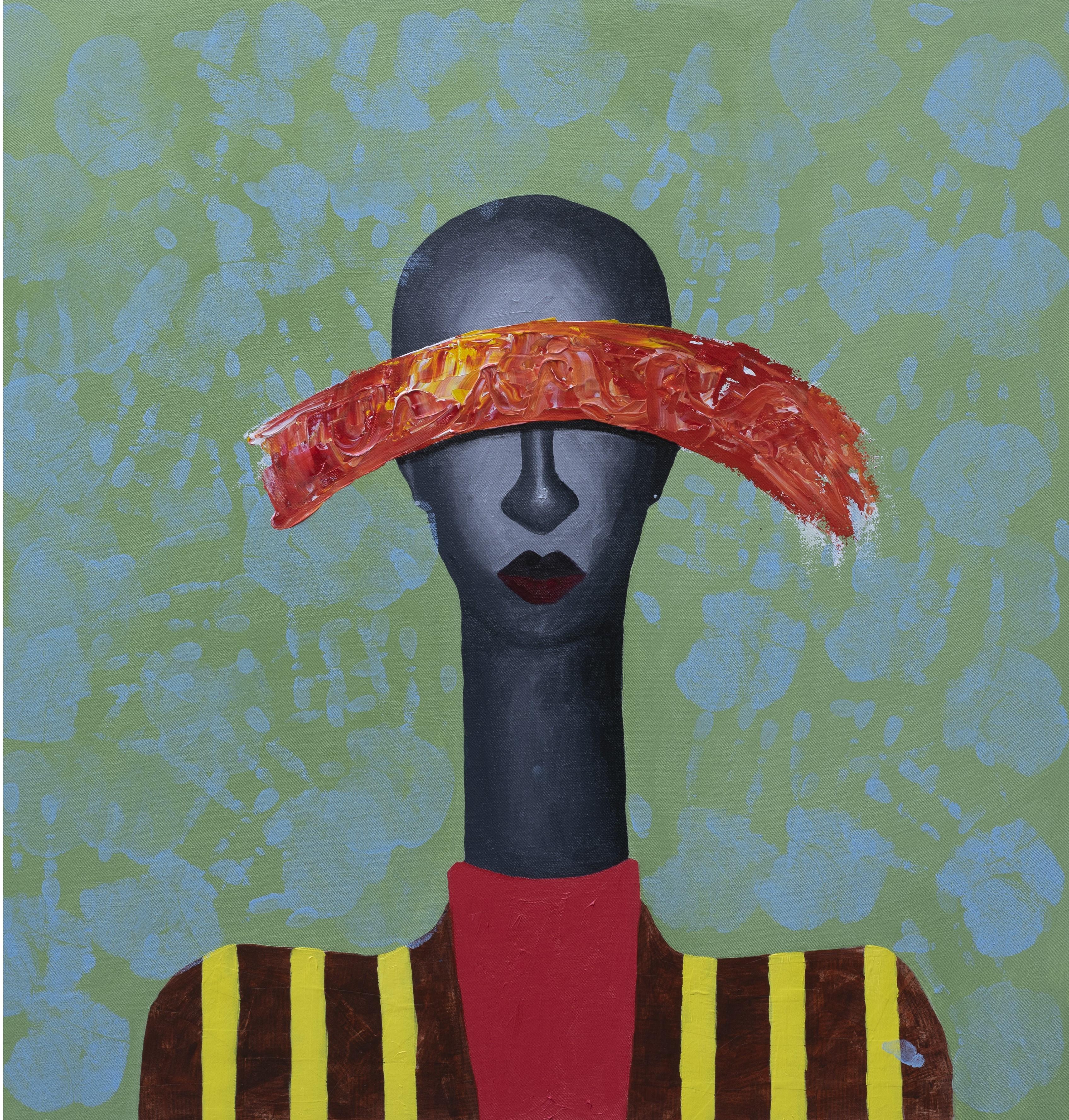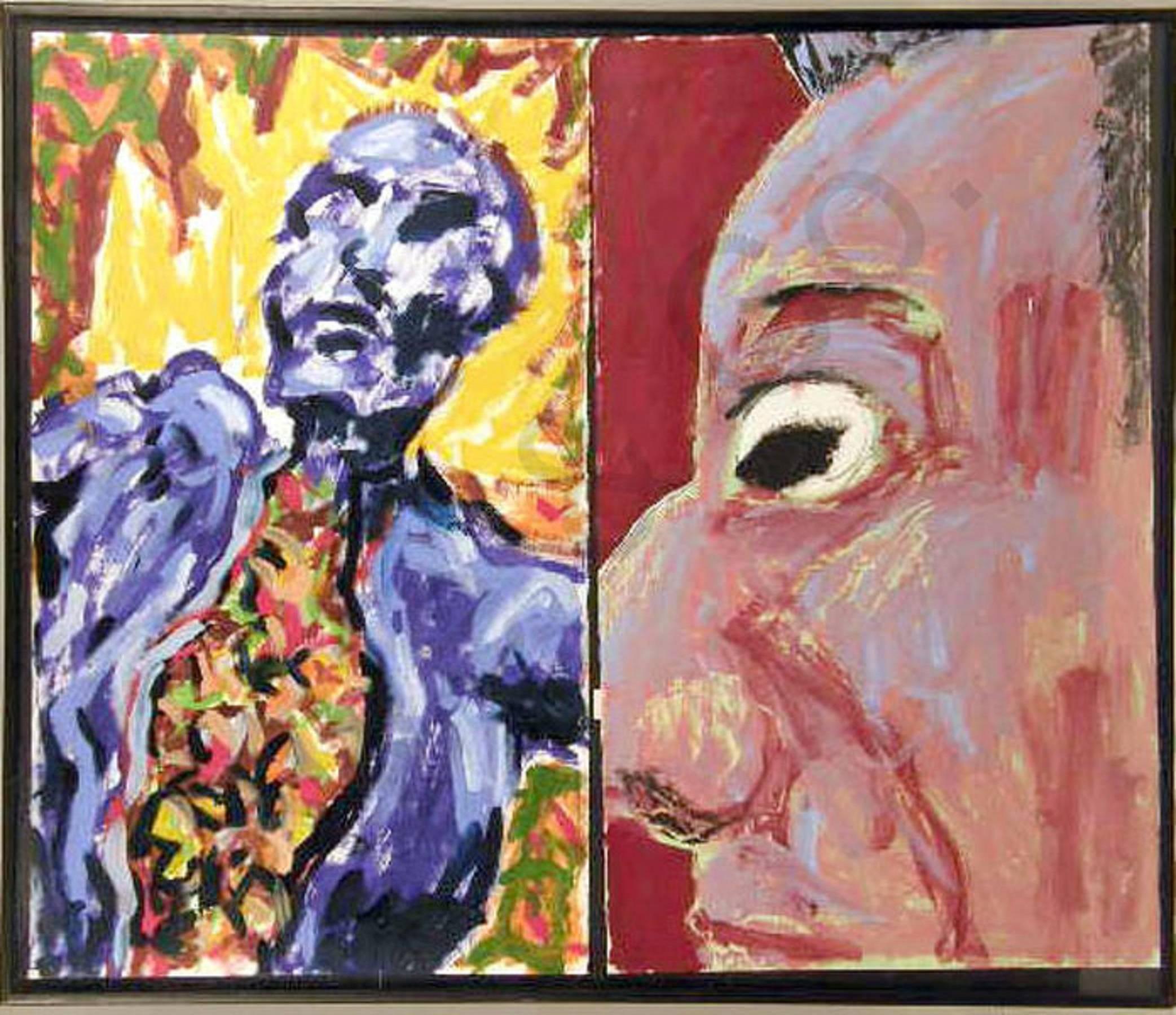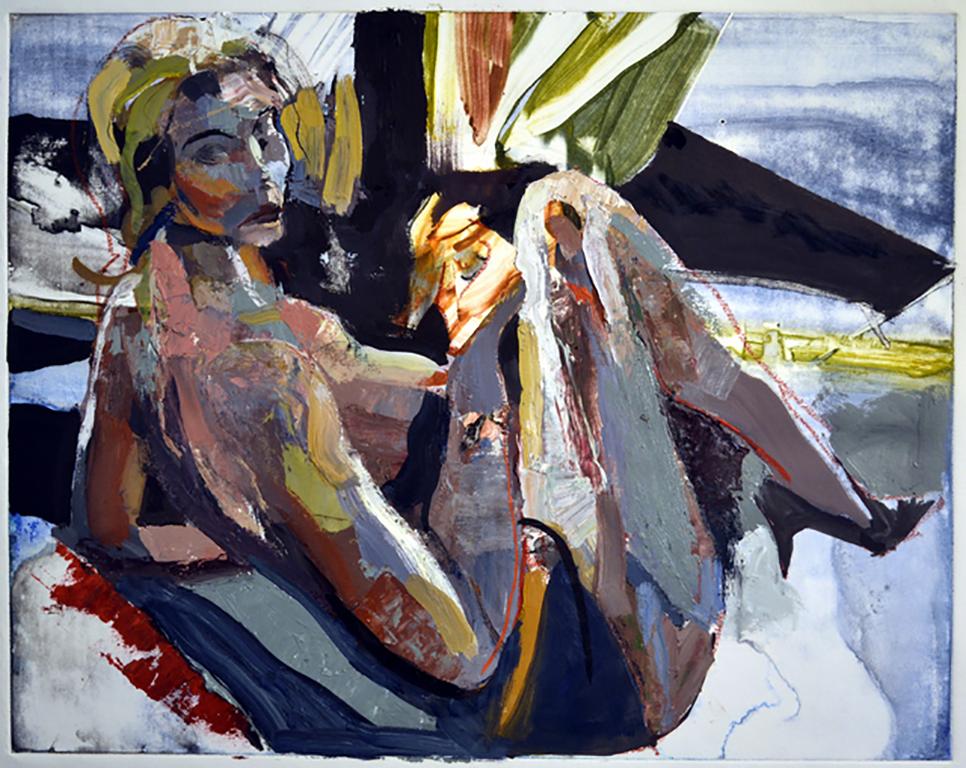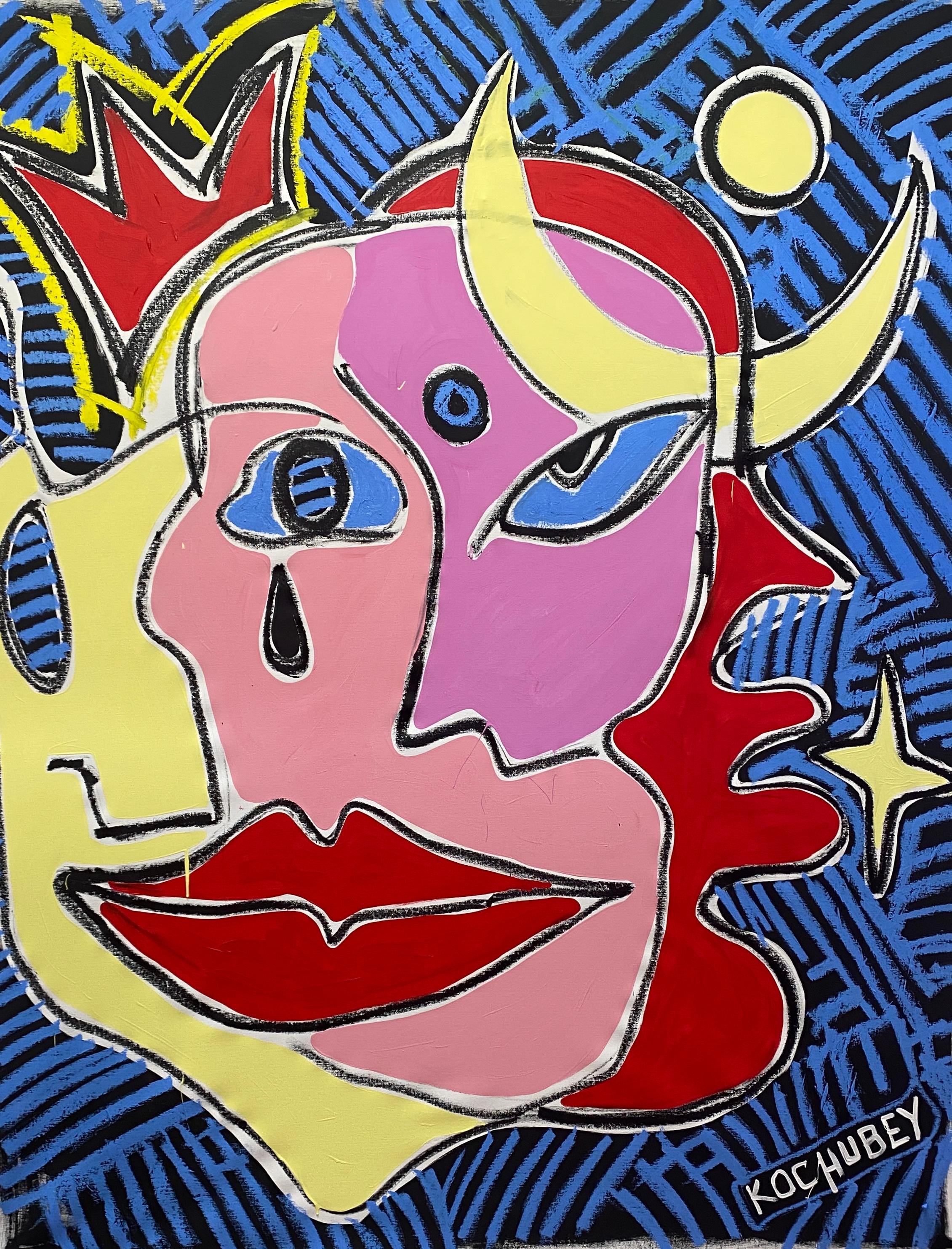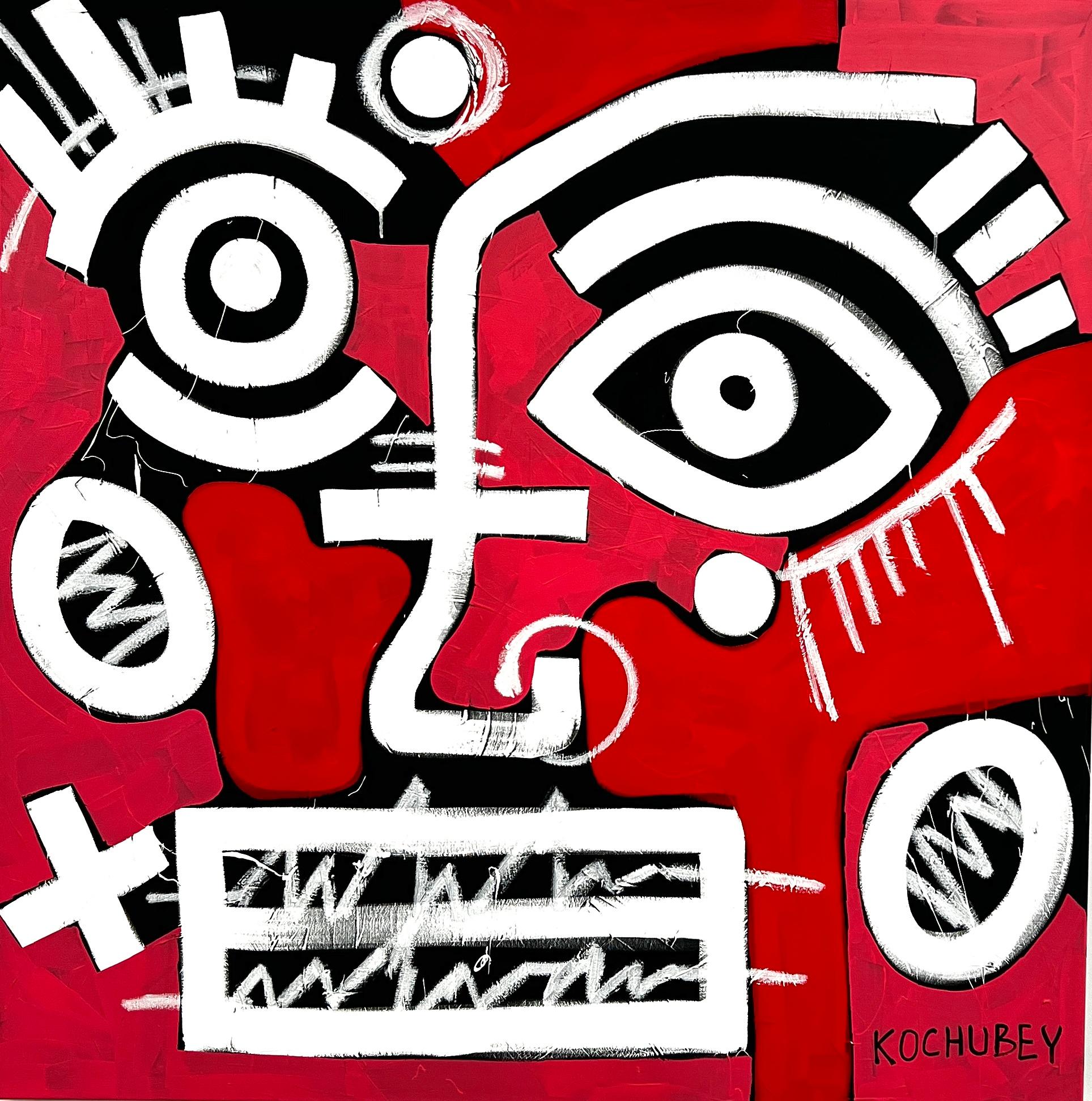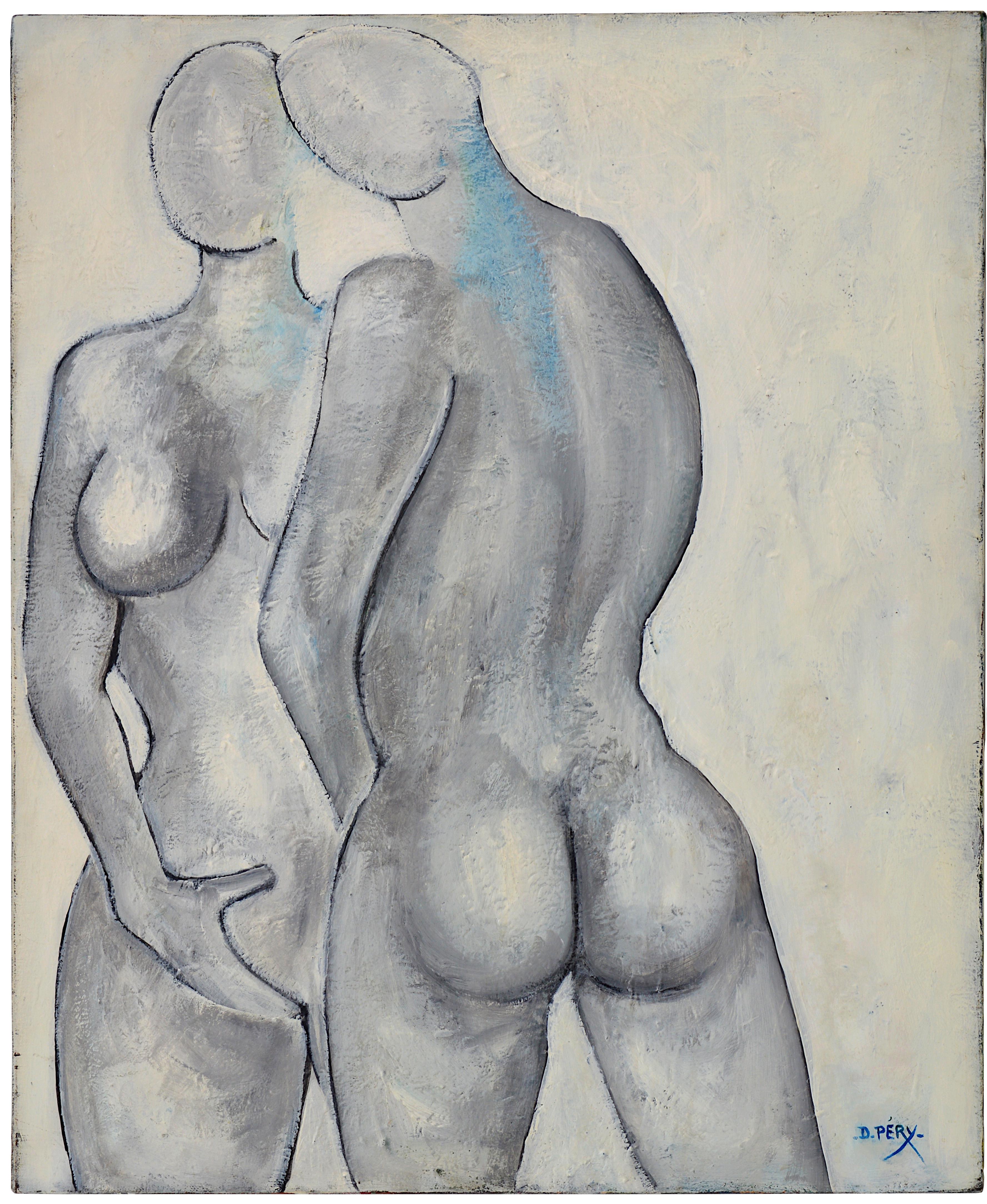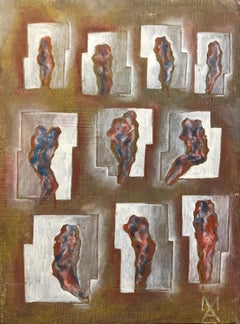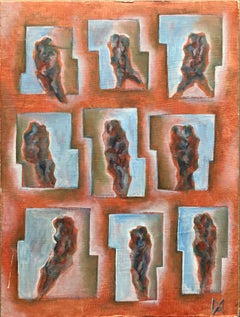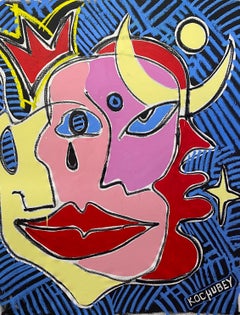
UNTITLED, 1981 DIPTYCH Neo Expressionist Figures
View Similar Items
Want more images or videos?
Request additional images or videos from the seller
1 of 7
Peter JulianUNTITLED, 1981 DIPTYCH Neo Expressionist Figures1981
1981
About the Item
- Creator:Peter Julian (1952, American)
- Creation Year:1981
- Dimensions:Height: 52.5 in (133.35 cm)Width: 62 in (157.48 cm)
- Medium:
- Movement & Style:
- Period:
- Condition:
- Gallery Location:Surfside, FL
- Reference Number:1stDibs: LU3822055923
About the Seller
4.9
Platinum Seller
These expertly vetted sellers are 1stDibs' most experienced sellers and are rated highest by our customers.
Established in 1995
1stDibs seller since 2014
1,549 sales on 1stDibs
Typical response time: 1 hour
More From This SellerView All
- UNTITLED, 1981 DIPTYCH Neo Expressionist Figures Peter Julian Oil PaintingBy Peter JulianLocated in Surfside, FLPeter Julian (born 1952 in Buffalo, New York) is an American artist best known for his Neo-expressionist paintings in the 1980s. His first major exhibition was in New York in 1982 at The New Museum as part of the museum’s annual “New Work/New York” series of exhibitions. THis piece is from that exhibition. (New Work / New York. 1982; 34 pages; staple-bound; 34 pages; 44 b/w illustrations. Essays by Lynn Gumpert and Ned Rifkin. Foreword by Marcia Tucker. Artists: Tom Butter, Tom Evans, John Fekner, Judith Hudson, Peter Julian, Cheryl Laemmle...Category
1980s Neo-Expressionist Figurative Paintings
MaterialsPaper, Oil
- Matthias Alfen German Sculptor Modern Expressionist Painting PsychogramBy Matthias AlfenLocated in Surfside, FLMatthias Alfen’s series of Janus figures are an innovation in figural art predicated on the advances made by the Futurist sculptor and painter Umberto Boccioni and the Modernist Alberto Giacometti. The qualities of chance and spontaneity, necessarily excluded in the sculptural work, are clearly evident in his drawings and paintings. “Psychograms” of unchoreographed hand movements display wide variation, repeatedly playing through one form after another. In the end, this multitude of variation serves to enhance the logic, consistency, and seductively rich appearance of Alfen’s designed sculptural works. Represented by Gallery Schuckin in New York, Paris, France, and Moscow, Russia. Matthias Alfen’s was strongly influenced by his family’s experience during World War II. His grandfather Klemens Alfen (1894-1955) was an accomplished painter and photographer, recognized for his landscape photography and for his technique (Special Honors for Excellence in Photo-Print Technology, 1932). He enjoyed the friendship and support of many in the artistic community, a community largely influenced by its German Jewish members. Having lost his entire circle of friends under Nazi oppression. Klemens, although not Jewish, also suffered under the Nazis for refusing to join them and struggling in post-war Germany, which had nothing to offer an artist like him, Klemens took his own life. At around the age of 16 he worked for some weeks as an assistant at his uncle’s art studio. Fritz Koenig...Category
Late 20th Century Neo-Expressionist Abstract Paintings
MaterialsPlywood, Oil
- Matthias Alfen German Sculptor Modern Expressionist Painting PsychogramBy Matthias AlfenLocated in Surfside, FLMatthias Alfen’s series of Janus figures are an innovation in figural art predicated on the advances made by the Futurist sculptor and painter Umberto Boccioni and the Modernist Alberto Giacometti. The qualities of chance and spontaneity, necessarily excluded in the sculptural work, are clearly evident in his drawings and paintings. “Psychograms” of unchoreographed hand movements display wide variation, repeatedly playing through one form after another. In the end, this multitude of variation serves to enhance the logic, consistency, and seductively rich appearance of Alfen’s designed sculptural works. Represented by Gallery Schuckin in New York, Paris, France, and Moscow, Russia. Matthias Alfen’s was strongly influenced by his family’s experience during World War II. His grandfather Klemens Alfen (1894-1955) was an accomplished painter and photographer, recognized for his landscape photography and for his technique (Special Honors for Excellence in Photo-Print Technology, 1932). He enjoyed the friendship and support of many in the artistic community, a community largely influenced by its German Jewish members. Having lost his entire circle of friends under Nazi oppression. Klemens, although not Jewish, also suffered under the Nazis for refusing to join them and struggling in post-war Germany, which had nothing to offer an artist like him, Klemens took his own life. At around the age of 16 he worked for some weeks as an assistant at his uncle’s art studio. Fritz Koenig...Category
Late 20th Century Neo-Expressionist Abstract Paintings
MaterialsPlywood, Oil
- Matthias Alfen German Sculptor Modern Abstract Expressionist Painting PsychogramBy Matthias AlfenLocated in Surfside, FLFigurative Abstraction gestural painting. Matthias Alfen’s series of Janus figures are an innovation in figural art predicated on the advances made by the Futurist sculptor and painter Umberto Boccioni and the Modernist Alberto Giacometti. The qualities of chance and spontaneity, necessarily excluded in the sculptural work, are clearly evident in his drawings and paintings. “Psychograms” of unchoreographed hand movements display wide variation, repeatedly playing through one form after another. In the end, this multitude of variation serves to enhance the logic, consistency, and seductively rich appearance of Alfen’s designed sculptural works. Represented by Gallery Schuckin in New York, Paris, France, and Moscow, Russia. Matthias Alfen’s was strongly influenced by his family’s experience during World War II. His grandfather Klemens Alfen (1894-1955) was an accomplished painter and photographer, recognized for his landscape photography and for his technique (Special Honors for Excellence in Photo-Print Technology, 1932). He enjoyed the friendship and support of many in the artistic community, a community largely influenced by its German Jewish members. Having lost his entire circle of friends under Nazi oppression. Klemens, although not Jewish, also suffered under the Nazis for refusing to join them and struggling in post-war Germany, which had nothing to offer an artist like him, Klemens took his own life. At around the age of 16 he worked for some weeks as an assistant at his uncle’s art studio. Fritz Koenig...Category
Late 20th Century Neo-Expressionist Abstract Paintings
MaterialsPlywood, Oil
- Large Venezuelan Expressionist Oil Painting Diego Barboza Latin American MasterLocated in Surfside, FLDiego Barboza - 1945-2003 Hand signed and dated 1988 Oil on Canvas Diego Barboza was born the Carabobo street of Maracaibo, Venezuela on February 4, 1945. He was a Venezuelan Neo Figurative Painter who is among the most famous and influential figures in Venezuelan art history. Diego Barboza opened a new chapter in Latin America, beyond the surreal or the magical realism of the Modern Latin American Masters. He created a new language of dislocation and transgression. Personages became distorted to the point that was very exaggerated forms His figures twisted and contorted without losing their presence or their pull. Extremities muscles, and bones burst into an explosive compound of divergent and convergent lines. Through eruptive brushstrokes and fractured outlines. Barboza created a world of illusions. Barboza was born into a upper-middle-class family. He stopped going to school at 12 years old, and he registered himself at the School of Visual Art in the City of Maracaibo Venezuela. Barboza studied at the School of Visual Arts in Caracas, Venezuela. Barboza began his training as an artist at age 12 in his native Maracaibo when he left formal education to enroll in the then School of Plastic Arts of Zulia, then Julio Arraga School of Plastic Arts, where he was a student in the modeling, collage and Drawing of Angelina Curiel. His first collages, in the sixties, show the influence of American Pop Art. In 1967 he exhibited at the Ateneo de Caracas his series 'Los Ratones', a proposal then 'criticized by critics as unprecedented in Venezuela'. In his tribute to the film "Nosferatu" Friedrich Murnau included 32 drawings as well as two-dimensional objects. In 1968 he moved to London where he studied at the London College of Printing. From that time is his '30 Girls with Nets', an action in which 30 students of the London College of Printing, dressed in black and covered by white nets, toured London public places, behaving naturally. His 'street expressions', which he later called 'poetic actions', symbolized a breakdown of social restraints through unusual behaviors that sought to provoke public reactions. Upon his return to Venezuela in 1973, Barboza continues with this line of work, being recognized as one of the initiators of Venezuelan conceptual art. In the 1980's Diego Barboza turned to painting, the New Venezuelan Figuration. Here belongings and the feminine figure fill the work of that time, in which he embodied his intimacy and daily life through scenes of furnishings and flowers that included objects from his workshop and home. His nudes were made from live model, then to follow the path of distortion resulting in their unmistakable females: a figure that represented their personal way of appreciating beauty. Barboza presented his first individual exhibition at the Centro de Bellas Artes of Maracaibo Venezuela. In 1963, he traveled to London when the Conceptual Art movement started, he had the support of the London New Art Lab Gallery. On March 7, 1970 Barboza displayed his first work on Conceptual Art, which he called Art of Action. In London with the performance of 30 Girls with nets (30 Muchachas con redes). His second work was Nets and Hats in markets and restaurants (Con sombreros y redes en mercados y restaurantes). In London UK. His third The Centerpiece (El Ciempies) and the fourth Expression on a laundry-mat (Expresiones en una lavandería) In 1974. Baboza returned to Venezuela. Where he presented two very important Conceptual Art works: The Armadillo Box (La Caja del Cachicamo) and from the School of Athens to the New School of Caracas (De la Escuela de Atenas a la Nueva Escuela de Caracas). Closing his cycle of Conceptual Art creation. IN Venezuela a sort of impromptu academy started up at Claudio Perna’s house. Eugenio Espinoza, Roberto Obregón, Antonieta Sosa, Alfred Wenemoser, Yeni and Nan, Sigfredo Chacón, Diego Barboza, Luis Villamizar, Margherita D’Amico, Pedro Terán, Alfredo del Mónaco, as well as international figures who happened to be visiting Venezuela such as Antoni Muntadas, Charlotte Moorman, and Roman Polanski would gather there. Venezuela, especially Caracas, was a rich field of action for modernism in South America. Venezuelan Geometric Abstraction, Op art and Kinetic Art dominated through crucial figures like Jesús Rafael Soto, Gego, Alejandro Otero, and Carlos Cruz Diez, the country’s kinetic art made a fundamental contribution internationally. The Greater London Arts Association and the Arts Council of Great Britain did several exhibitions of (North, Central, South, London, Wales, Scotland and Ulster) to show the actual Visual Arts in all of the United Kingdom and Diego Barboza was invited for this event with a solo exhibition, expressions around a cylinder (Expresiones alrededor de un cilindro). Diego has made numerous solo and group exhibitions, obtaining rewards since 1963. He is represented in the most important museums of Venezuela, as well as in England, Brazil, Colombia and Cuba. In 1986 he was awarded the Municipal Visual Arts Award of the Municipal Council of the Federal District and in 1997 he received the National Prize for Plastic Arts granted by the National Council of Culture, CONAC. Select Group Exhibitions 1964 Ateneo de Caracas, Caracas, Venezuela 1965 Salón Arturo Michelena, Valencia, Venezuela 1968 Salón Oficial Museo de Bellas Artes, Caracas, Venezuela 1971 Art Spectrum London, London, Great Britain 1972 Serpentine Gallery, London, Great Britain 1973 Midland Group Gallery, London, Great Britain 1974 Galería BANAP, Caracas, Venezuela 1975 Casa de Las Américas, La Habana, Cuba Museo de Bellas Artes, Caracas Galería de Arte Nuevo, Buenos Aires, Argentina 1976 Museo de Arte Moderno, Bogotá, Colombia Museo de Arte Contemporáneo, Sao Paulo, Brazil Museo de la Tertulia, Cali, Colombia Bienal de Venecia, Venecia, Italy 1979 Centro de Artes y Comunicación, Buenos Aires, Argentina 1980 Galería NBC, Memphis, Tennessee, USA 1981 Galería de Arte Nacional, Caracas, Venezuela Museo de Arte Contemporáneo, Medellín, Colombia Museo de Bellas Artes, Caracas, Venezuela 1986 Museo de Arte La Rinconada, Caracas, Venezuela 1989 Galería Venzor, Chicago, Illinois, USA 1990 Museo Bellas Artes, Santiago de Chile, Chile 1992 Ambrosino Gallery, Coral Gables, Florida, USA 1993 Museo de Arte de Petare, Caracas, Venezuela Centro de Arte Lia Bermúdez, Maracaibo, Venezuela 1994 Galería Namia Mondolfi, Caracas, Venezuela 1995 Galería Art Nouveau, Maracaibo, Venezuela Galería Cesar Sassòn, Caracas, Venezuela Maremares Resort, Puerto La Cruz, Venezuela Galería Durban, Caracas, Venezuela Galería Odalys, Caracas, Venezuela 1996 Centro de Arte Grupo Li, Caracas, Venezuela Galería Uno, Caracas, Venezuela Centro Cultural Consolidado, Caracas, Venezuela Espacios Unión, Caracas, Venezuela Hebraica, Caracas, Venezuela 1997 Sociedad Dramática, Maracaibo, Venezuela, Venezuela CELARG, Caracas, Venezuela Galería Ocre Arte, Caracas, Venezuela Museo de Arte Contemporáneo , Maracay, Venezuela Galería Medicci, Caracas, Venezuela Awards 1963 Premio Estímulo - IX Salón d’Empaire, Maracaibo, Venezuela 1964 Premio José Ortìn Rodríguez - X Salón d’Empaire, Maracaibo, Venezuela 1965 Primer Premio de Dibujo - III Salón Pez Dorado, Caracas, Venezuela 1968 Premio Henrique Otero Vizcarrondo - XXIV Salón Oficial Anual de Arte Venezolano Museo de Bellas Artes, 1973 Premio Emilio Boggio...Category
1980s Neo-Expressionist Figurative Paintings
MaterialsCanvas, Oil
- Figurative Expressionist Bold Pop Art Oil Painting Self Portrait Carlo PittoreBy Carlo PittoreLocated in Surfside, FLCarlo Pittore Oil on canvas, 1984, Self Portrait, initialed and dated lower left, slat framed, 21"sqr (frame) 20 X 20 canvas. Provenance: The Private Collection of Wolf Kahn & Emily Mason Carlo Pittore (1943 – 2005) born Charles J. Stanley was an American painter, educator, art activist, and publisher, whose primary study, teaching and body of work was figurative art and portrait painting. He was a pioneer in the Mail Art movement, he corresponded with such mail art luminaries as Buster Cleveland and Ray Johnson. Pittore is noted for opening the first independent art gallery in the East Village, Manhattan. In 1987, Pittore founded "The Academy of Carlo Pittore" in Bowdoinham, Maine. Pittore (née Charles Stanley) was born to Stanford and Estelle Stanley in Queens, New York. He grew up on Long Island, in Port Washington, New York with his sister Marion and brother Elliott. Pittore graduated from Port Washington High School (1961), where he was active in the political and debating scenes. He then went on to graduate from the School of the Museum of Fine Arts at Tufts (1966), and post graduate from the Brooklyn Museum Art School (1978). Pittore changed his name in the 1970s while studying abroad in Rome, Italy. The children nicknamed him "Carlo Pittore", (”Charles the Painter"). From there he went on to study at the Chelsea College of Arts in London. In 1978, Pittore received the Max Beckmann Scholarship in Advanced Painting. It allowed him to begin studying with American feminist painter Joan Semmel at the Brooklyn Museum Art School. He also studied with visual portrait artist Alice Neel. After which, he taught art at the New York Cultural Foundation. In the 1970s, Pittore and his close friend Bern Porter...Category
1980s Neo-Expressionist Figurative Paintings
MaterialsCanvas, Oil
You May Also Like
- The Lost One 1Located in Ibadan, OyoChidebe's work explores the complexities of personal identity. "The Lost One" portrays a solitary figure set against a backdrop of muted space, symbolic of the protagonist's journey ...Category
21st Century and Contemporary Neo-Expressionist Figurative Paintings
MaterialsCanvas, Oil, Acrylic, Newsprint
- Muddy Company oil on monotypeBy Tom BennettLocated in Brooklyn, NYprovocative female figure Oil on paper Tom Bennett’s practice is rooted in the classical tradition where painting and drawing from life is highly regarded. Bennett’s work is heavily influenced by Francis Bacon, Frank Auberbauch and foremost his father, Harry Bennett, who was also an artist. Tom’s time living abroad in Spain and traveling through Eastern Europe and Africa provided the artistic freedom to explore many of the techniques and subject matter that continue to define his practice. Bennett was born and raised in Connecticut. His mediums include monotypes, oil on paper, canvas or styrene board. In a technique that Tom started over 4 years ago, several of his monotypes have been painted over with oil paint using a palette knife, brush, or his fingers to repurpose the underlying image. These works are a testament to Bennett’s ability to quickly and concisely compose an image with expressive brush strokes, foreshortened figures and expertly rendered light. Tom’s work has been featured in group and solo exhibitions worldwide. Bennett lives and works in Brooklyn, New York. He is currently represented by Tabla Rasa...Category
2010s Neo-Expressionist Figurative Paintings
MaterialsPaper, Oil
- "Magicians Dream" Painting 71" x 59" inch by Vera KochubeyBy Vera KochubeyLocated in Culver City, CA"Magicians Dream" Painting 71" x 59" inch by Vera Kochubey * * * SHIPPED: ROLLED CANVAS * * * The majority of Kochubey’s paintings take the form of hea...Category
21st Century and Contemporary Neo-Expressionist Figurative Paintings
MaterialsCanvas, Mixed Media, Oil, Acrylic
- "RED POWER" Abstract Painting 57" x 57" inch by Vera KochubeyBy Vera KochubeyLocated in Culver City, CA"RED POWER" Abstract Painting 57" x 57" inch by Vera Kochubey * * * SHIPPED: ROLLED CANVAS * * * The majority of Kochubey’s paintings take the form of heavily symbolic portraits,...Category
21st Century and Contemporary Neo-Expressionist Figurative Paintings
MaterialsCanvas, Mixed Media, Oil, Acrylic
- Vicente Cristellys, Oil on canvas "Gina Lollobrigida", Late 1950sBy Vicente CristellysLocated in Saint Amans des cots, FROil on canvas by Vicente CRISTELLYS (1898-1970), School of Paris, late 1950s. "Lolo", portrait of Gina Lollobrigida in Notre-Dame de Paris (film). Arriving in Paris during the 1920s, Vicente Cristellys settled in Montparnasse like many of his colleagues from the Ecole de Paris. He paints characters and scenes largely inspired by his native Spain. It was after a bohemian period that he began to illustrate cinema posters and he managed to settle in the Parisian cinematographic milieu. For example, he will sign posters for The Big Sleep, The Man in The iron mask...Category
1950s Neo-Expressionist Portrait Paintings
MaterialsCanvas, Oil
- VILLERS, Pride, Oil on Canvas, 1972Located in Saint Amans des cots, FROil on canvas by VILLERS, France, 1972. Pride. With frame : 84.5 x 65 x 5 cm - 33.3 x 25.6 x 2 in. , without frame : 80 x 60 x 2 cm - 31.5 x 23.6 x 0.8 in. Signed and dated lower ...Category
1970s Neo-Expressionist Animal Paintings
MaterialsCanvas, Oil
